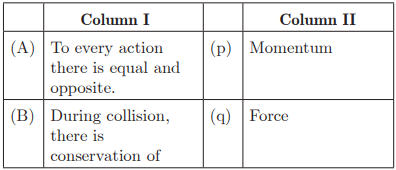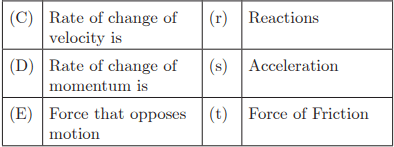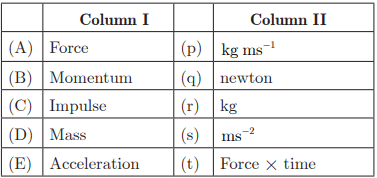Class 9 Science Chapter 8 Practice Question Answers - Force and Laws of Motion
Multiple Choice Questions
Q1: Identify the correct statement(s).
1. To accelerate the motion of an object, a balanced force is required.
2. Balanced forces do not change the state of rest or of motion of an object.
3. Balanced forces do not produce any acceleration, they can change the shape or size of the body.
(a) 1 and 2
(b) 2 and 3
(c) 1 and 3
(d) None of these
Ans: (b)
To accelerate the motion of an object, an unbalanced force is required.
Q2: A number of forces acting on a body changes velocity of the body. The forces cannot be
(a) paralleled
(b) unbalanced
(c) balanced
(d) inclined
Ans: (c)
When a number of forces acting on a body change velocity of body, they produce a non zero acceleration, the forces are unbalanced, parallel and inclined.
Q3: The momentum of a body of given mass is proportional to its
(a) velocity
(b) size
(c) shape
(d) all of these
Ans: (a)
As p = mv, for given mass p ∝v
Q4: Newton’s second law of motion gives us a measure of
(a) force
(b) inertia
(c) mass
(d) acceleration
Ans: (a)
Newton’s second law of motion gives us a measure of force.
Q5: A body, whose momentum is constant, must have constant
(a) force
(b) velocity
(c) acceleration
(d) all of these
Ans: (b)
For a given mass, p ∝ v. If the momentum is constant then its velocity must be constant.
Q6: The momentum of an object at a given instant is independent of its
(a) inertia
(b) mass
(c) velocity
(d) acceleration
Ans: (d)
The momentum of a body is the product of its mass and its velocity at that instant. The momentum of an object at a given instant is independent of its acceleration.
Q7: Read the given statements and select the correct option.
Statement 1 : The forces of action and reaction always appear due to actual physical contact of two bodies.
Statement 2 : A particle can move only under the action of a force.
(a) Both statements 1 and 2 are true and statement 2 is the correct explanation of statement 1.
(b) Both statements 1 and 2 are true but statement 2 is not the correct explanation of statement 1.
(c) Statement 1 is true but statement 2 is false.
(d) Both statements 1 and 2 are false.
Ans: (d)
There is no need of actual physical contact of two bodies for the forces of action and reaction to appear. Suppose if two bodies are separated by some distance and the first body is attracting the second body by a gravitational force F1 then the second body will also attract the first body with the same gravitational force.
If a particle is moving with constant speed it will continue to move with that speed until an external force is applied.
Q8: A body is accelerating in a straight line. The unbalanced force acts
(a) in the direction of motion of the body.
(b) in a direction opposite to the direction of motion.
(c) in a direction perpendicular to the direction of motion of the body.
(d) none of these
Ans: (a)
When a body is accelerating in a straight line, the unbalanced force acts in the direction of motion of the body.
Q9: A man is standing on a boat in still water. If he walks towards the shore the boat will
(a) move away from the shore
(b) remain stationary
(c) move towards the shore
(d) sink
Ans: (a)
According to Newton’s third law, the boat will move away from the shore.
Q10: A cannon after firing recoils due to
(a) conservation of energy
(b) Newton’s third law of motion
(c) Newton’s first law of motion
(d) none of these
Ans : (b)
A cannon after firing recoils due to Newton’s third law of motion
Q11: An unbalanced force acts on a body. The body
(a) must remain in same state
(b) must move with uniform velocity
(c) must be accelerated
(d) must remain at rest
Ans : (c)
When unbalanced force acts on a body, the body will be accelerated.
Q12: A hockey player pushes the ball on the ground. It comes to rest after travelling certain distance because
(a) the player stops pushing the ball.
(b) balanced force acts on the ball.
(c) the opposing force acts on the ball.
(d) none of these
Ans : (c)
The opposing force of friction acts on the ball.
Q13: Which of the following has the largest inertia?
(a) Pin
(b) An ink pot
(c) Pen
(d) Our budy
Ans: (d)
Out of the four choices, our body is the heaviest. Hence, it has the largest inertia.
Q14: How much force acts on a body whose momentum (P) is constant with time (t)?
(a) Zero
(b) p/2t
(c) 2p/t
(d) None of these
Ans: (a)
Force is the rate of change of momentum. So, momentum is constant when force is zero.
Q15: A football has lesser inertia than a stone of the same size because
(a) football has more air inside than the stone
(b) football has less air inside than the stone
(c) football has less mass than the stone
(d) football has more mass than the stone
Ans :
Massive object has more inertia. Hence, inertia of stone is more than that of a football of same size.
Fill in the blanks.
Q16: .......... is equal to change in momentum.
Ans : impulse
The term 'Impulse' is equal to the change in momentum of an object. In physics, impulse is the integral of a force over the time interval, and it is responsible for the change in an object's momentum. It is calculated by multiplying the force acting on the body by the time for which it acts. Thus, it gives us a measure of the overall effect of the force on the object's motion.
Q17: When a running car stops suddenly, the passengers are jerked ..........
Ans : forward
When a running car stops suddenly, the passengers are jerked forward. This happens due to the law of inertia which states that an object in motion tends to stay in motion. When the car stops, the body of the passengers wants to continue moving forward, and this gives the feeling of being jerked or pushed forward until a force (like a seatbelt) stops them.
Q18: If there are several forces on an object, its acceleration depends on its mass and the .......... force.
Ans : net unbalanced.
If several forces are acting on an object, its acceleration doesn't depend on the individual forces but on the net unbalanced force acting on the object. This is according to Newton's second law of motion, which states that the acceleration of an object is directly proportional to the net force acting on it and inversely proportional to its mass.
Q19: .......... is a measure of the inertia of a body.
Ans : mass
'Mass' is a measure of the inertia of a body. Inertia is the property of a body due to which it resists any change in its state of rest or uniform motion. The mass of an object is a quantitative measure of inertia. The greater the mass of an object, the greater is its inertia, i.e., the greater is its resistance to change in its state of rest or uniform motion.
Q20: The change in the velocity of an object is proportional to the ......... applied to it.
Ans : impulse
The change in the velocity of an object is proportional to the 'impulse' applied to it. In simpler terms, impulse is the overall effect of a force on an object's motion. If we apply a greater impulse on an object, it will accelerate more and hence its velocity will change more. This is the essence of Newton's Second Law of Motion.
True/False
Direction: Read the following statements and write your answer as true or false.
Q21: Action and reaction act on the same body.
Ans : False
The statement is false because according to Newton's third law of motion, action and reaction forces act on different bodies, not the same one. If you push a book, your hand exerts a force on the book (action), and the book exerts an equal and opposite force on your hand (reaction). These forces are applied to different bodies.
Q22: When we push our foot against the ground backwards (action), the ground exerts an equal and opposite force (reaction) on our foot which causes us to more forward.
Ans : True
This statement is true based on Newton's third law of motion. When we push our foot against the ground backwards (action), the ground reacts by exerting an equal and opposite force (reaction) on our foot, causing us to move forward. This action-reaction force pair is what allows us to walk or run.
Q23: It is easier to start motion in a lighter body than a heavier body.
Ans : True
The statement is true as lighter bodies have less inertia compared to heavier bodies. Inertia is the property of a body to resist change in its state of motion. A lighter body has less inertia, meaning it is easier to overcome the resistance and start motion in it than in a heavier body.
Q24: The product of the mass of a body and its velocity is called inertia.
Ans : False
The statement is false because the product of the mass of a body and its velocity is called momentum, not inertia. Inertia is the tendency of an object to resist a change in its motion and it depends solely on the mass of an object, not its velocity.
Q25: Action and reaction force acts on the same object.
Ans : False
The statement is false. According to Newton's third law of motion, every action has an equal and opposite reaction. However, these forces do not act on the same object. The action force acts on one object, and the reaction force acts on another. For example, if you push a wall, your force is acting on the wall, but the wall's reaction force is acting on you.
Matching Questions
Direction: Each question contains statements given in two columns which have to be matched. Statements (A,B,C,D,E) in Column I have to be matched with statements (p,q,r,s,t) in Column II.
Q26:

Ans : (A) (r), (B) (p), (C) (s), (D) (t), E (q)
Q27:
Ans : (A) (q), (B) p, (C) t, (D), r, (E) s
|
84 videos|384 docs|61 tests
|





















